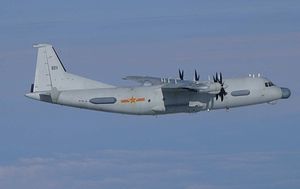The Japan Air Self Defense Force (JASDF) scrambled fighter jets on February 23 to intercept a Chinese People’s Liberation Army Air Force (PLAAF) Shaanxi Y-9JB (GX-8) electronic warfare and surveillance plane crossing the Sea of Japan and East China Sea via the Tsushima Strait, a channel connecting the Sea of Japan, the Yellow Sea, and the East China Sea.
Japanese airspace was reportedly not violated, the MoD reports.
It was the first intercept of a Chinese aircraft in eight weeks. The last intercept of a Chinese military aircraft near the Japanese islands occurred on December 27, when JASDF also intercepted a Y-9JB aircraft. A previous intercept took took place on December 14. The JASDF also conducted scrambles against PLAAF and People’s Liberation Army Navy Air Force (PLANAF) aircraft on November 26 and on October 29. Additionally, intercepts took place on August 29 and July 27. Furthermore, a Y-9JB, flying through international airspace between Okinawa and Miyako, was intercepted in June.
The PLAAF and PLANAF usually conduct their surveillance patrols with Y-9JBs, an upgraded variant of China’s first-generation Y-8DZ and Y-8G electronic reconnaissance aircraft, over the East China Sea and Sea of Japan at four-week intervals. Up until September 2018, a total of 345 Chinese intercepts have been recorded by the JASDF for the year. This constitutes an increase of 58 sorties, in comparison to fiscal year 2017. Past Chinese missions included H-6K long-range bombers, Tupolev Tu-154MD electronic intelligence planes, and Sukhoi Su-35 multirole fighter jets.
As during past PLAAF spy missions, the Y-9B also entered South Korea’s air defense identification zone (KADIZ) on February 23, according to South Korean media reports. “The aircraft entered the country’s air defense identification zone, called the KADIZ, at around 8:03 a.m. [local time] near Ieo Island and exited at 8:27 a.m.”, the South Korean Joint Chiefs of Staff was quoted as saying in a statement.
“It re-entered the KADIZ at 9:34 a.m. near the southeastern city of Pohang, and flew between Ulleung and the easternmost islets of Dokdo, eventually leaving the air defense zone at 12:51 p.m.” The Republic of Korea Air Force scrambled fighter jets in response. Air defense identification zones are not considered sovereign or territorial airspace and sections of the KADIZ overlap with air defense identification zones designated by China and Japan.
While the Y-9JB also entered Japan’s air defense identification zone, the incursion is not mentioned in the MoD statement.
Earlier this month, the JASDF intercepted four nuclear-capable Russian Tupolev Tu-95MS strategic bombers and four Sukhoi Su-35S (Flanker-E+) multirole fighter jets flying in two separate formations over the east and west coasts of Japan on February 15. The February 15 intercept took place after a three-and-a-half-week hiatus of Russian long-range patrols.

































